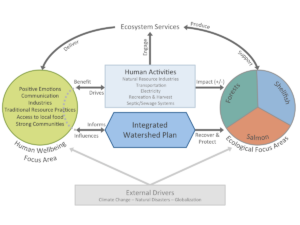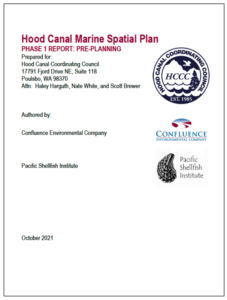As the LIO, HCCC works with its partners to develop, coordinate, and implement locally important ecosystem recovery actions aligned with the Hood Canal Integrated Watershed Plan, and the Puget Sound Action Agenda.
Hood Canal Recovery Plan
Our Integrated Approach
HCCC partnered with Tribes, local governments, organizations, state agencies, and community groups to produce the Hood Canal Recovery Plan (HCRP; previously known as the Integrated Watershed Plan). HCCC’s Board of Directors, with elected officials from each of Hood Canal’s five surrounding governments, has adopted the HCRP as the guiding strategy for management of Hood Canal’s natural resources.
Scroll down to learn more about the HCRP and how HCCC is putting it in action, or click the button below to view the entire document.
Applying the HCRP to the Real World
Hood Canal Landscape Assessment and Prioritization (LAP) Tool
The LAP Tool is a mapping and prioritization tool that puts the IWP’s strategic objectives and priorities onto the reality of Hood Canal’s complex landscape of waterways and shorelines, forests, working lands, and communities.
Hood Canal Shellfish Initiative
The Hood Canal Shellfish Initiative (HCSI) brought together shellfish partners from local tribes, county governments, state agencies, non-profit restoration groups, shellfish growers, researchers, and community members in a collaborative action planning process to protect Hood Canal’s shellfish resources and ensure the continued success of the communities who rely on them.
Hood Canal Marine Spatial Planning
HCCC piloted an effort exploring how to apply marine spatial planning to Hood Canal’s marine environment and resources. This effort grew out of HCSI Action Plan priorities to develop a decision-support tool that puts shared values into practice.
Hood Canal Marine Spatial Plan Phase 1 Report: Pre-planning
Learn more about Hood Canal projects and funding resources
Dive into the HCRP
The HCRP provides a framework for HCCC and our partners to identify priorities, refine strategies, and make choices to more collaboratively, strategically, and effectively protect the health of Hood Canal. It is organized around key ecosystem components and their most urgent stressors to prioritize our efforts, and guides HCCC and its partners to:
- Establish strategic priorities to guide regional actions towards our vision
- Track progress and provide accountability
- Identify implementation gaps and barriers
- Enable continued evaluation and adaptive management
Ecosystem Components
The HCRP focuses on four major ecosystem components – the species, ecological systems, or social systems that communities in Hood Canal value and desire to protect, restore, and steward.
These components were selected because of their importance to local communities, they are the emphasis of numerous management and conservation plans, and their many connections to other ecosystem elements.
Measuring Our Success
Measurable Indicators were selected for each ecosystem component to evaluate the Hood Canal ecosystem’s ongoing health and the success of our efforts. Learn more about HCRP ecosystem indicators at Our Hood Canal.

Learn about Hood Canal's ecosystem health
What Does it Mean to be Integrated?
Hood Canal connects us. The quality of our environment, economy, community and individual wellbeing are entwined across its landscape. This body of water nurtures our quality of life and is in turn impacted by our presence on its shores and uplands. Hood Canal is a social-ecological system with a community closely tied to its natural resources. The graphic below illustrates those ties, and shows how the HCRP addresses HCCC’s strategic focus areas.
Hood Canal Integrated Social-Ecological System Conceptual Model

The HCRP reflects these relationships by prioritizing actions we can take to benefit all of Hood Canal. The plan highlights how our natural resource management is integral to all facets of life in Hood Canal, acknowledges decision-making tradeoffs, and develops solutions to complex problems across jurisdictions and watersheds.
HCRP Steering Committee
The HCRP Steering Committee is comprised of Hood Canal partners, experts in their field, with sage experience volunteered to advise HCRP strategic planning and HCCC programmatic implementation. The Steering Committee is advisory to the HCCC Board of Directors.
Learn more about the HCRP Steering Committee and its members (coming soon).
HCCC is the Local Integrating Organization (LIO) for Hood Canal
Library



